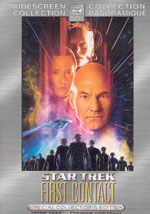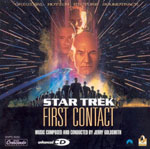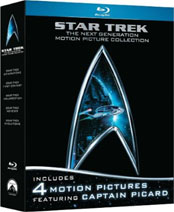
STAR TREK:
Star Trek Movies:
|
Star Trek 8: First Contactstory by Rick Berman, Brannon Braga and Ronald D. Moorescreenplay by Brannon Braga and Ronald D. Moore feature film, 111 minutes
I wanted very badly to give this film top marks when I first came out of the theatre during its debut week. But some aspects first required some deeper thought. Did its philosophies and methods of making extra-terrestrial contact match up with my own views? And had it not still fallen into Star Trek's usual trap of messing up time travel ridiculously? (Not too long after, I heard Leonard Nimoy say in an interview that he thought the film was flawed, and assumed he must be referring to the time travel bit.) Early on, the characters would like to have the audience believe that the history of their entire universe has been re-written and everything has changed, except (as usual) for the Enterprise and her crew. They of course were somehow miraculously spared by the "temporal wake" behind the Borg sphere that they are caught in - the latest version of Brannon Braga's "cloud" for creating new time travel phenomenon that will be speculated about but ultimately remain something of an unknown. As usual, a fountain of staple technobabble pours forth out of the characters as they try to figure out what is going on. Then it hit me. I didn't need to argue with anything that was SHOWN to happen in this film. I only had a problem with the explanation offered by Commander Data as he SPECULATED on what happened in ONE SHORT SCENE near the beginning. And Data's "map" just fell short of adequately describing the time travel "territory" of the film. For some reason, the Borg's temporal wake had slid the Enterprise and crew sideways into an alternate quantum reality, a "parallel" universe that showed them the result of the Borg's influence in the past should the Borg have their way. And why not, since the temporal wake visual effect isn't too dissimilar from the usual universe-connecting wormholes seen on the show "Sliders", where parallel universes are explored all the time. And when you really think about character, you remember that Data is not a great original thinker, he's more of an encyclopedia storing the sum total of Starfleet's knowledge. Starfleet typically isn't too brilliant when it comes to understanding time/choice mechanics, so of course Data will pull up the wrong idea first. It's just sad that the writers' understanding isn't any better, and they end up flaunting the wrong idea to the audience unchallenged. Brannon Braga had come so close to getting it right back in The Next Generation's seventh season with the episode "Parallels". Oh well. Maybe he'll truly get it one day. So the universe that the Enterprise E came from is still under Starfleet control, and they're busy salvaging the Defiant and wondering where the Borg sphere and the Enterprise went to. In yet another universe, the Borg control the Earth, and perhaps wonder why the blip of a temporal wake with an Enterprise caught in it appears in the sky for a brief time, and then disappears. Both of those universes co-exist. Both of the alternate histories from 2063 to 2373 co-exist. In fact, there are likely billions of alternate histories all co-existing out there. One of the real challenges for Enterprise E and her crew will be getting back to the one that they know. In that sense, it is a bit strange that the film wants to just assume that they find their exact home again, without showing a scene at the very end where they check to make sure that their present day that they return to looks enough like what they remember for them to feel comfortable in it. In all other senses though, you can't really fault what they attempt to do. Even if they are saving an alternate Earth from the Borg, it's preferable than letting the Borg have their way. For all the various ways the events of this film could turn out in all the countless parallel universes out there, it's nice to think that nearly every Borg sphere that makes the journey has an Enterprise chasing after it, stacking the odds in Earth's favour. Nice. And unlike "The City on the Edge of Forever" from the original series, or Deep Space Nine's third season "Past Tense" story, it is very easy to believe that an unchallenged Borg presence in 2063 will create the non-existence of Starfleet and the Federation some 300 years later. The in-between cause and effect along future history works out this time without a hitch.
The Prime Directive gets a brief mention as Dr. Crusher cuts her usual debate with Picard short at one point. Indeed, the Prime Directive is a good subject to bring up, because the Earth itself is about to cross the threshold of its most important jurisdiction. This subject matter is one of the brilliant strokes in the creation of this story. It is a critical period of future history in the Star Trek canon that had never really been explored before. Most fans were intensely curious just to find out what was supposed to have happened here. And because we're only in Star Trek's past for this one story, it remains fresh and interesting, avoiding some of the pitfalls that Scott Bakula's series later fell into. The film's subtitle "First Contact" would probably be perfect except for one glaring problem - The Next Generation TV series already had an episode with that title in its fourth season, dealing with an alien planet much like ours, on the verge of discovering warp drive, and encountering "alien" ambassadors from the Enterprise crew on official levels for the first time. I think the film should have chosen a different title to avoid confusion. From the perspectives of the Vulcans and the future Federation, the warp drive rules for making first contact are followed consistently, so all is good there. From the point of view of what I consider the wiser elements of the New Age movement here today, the Earth depicted in this film gets to approach First Contact from the right angle as well. Earthlings don't get away with just settling back into our backward habits and waiting for the aliens to come down and save us. We have to start following Dr. Stephen Covey's first Habit of Highly Effective People: We must be proactive in getting our butts far enough out into space that we can start meeting them. We must show up prepared to have a relationship of equality with them. Of course, threatening what is historically supposed to happen here with all kinds of time travellers from the future kind of diffuses the moment. Zephram Cochrane gets to meet a half-Betazed and have a few drinks with her before meeting the Vulcans. Lily also gets to meet a Klingon, plus Borg and crewmembers from all over the place before the official big moment. Plus you can add up either the number of other Star Trek aliens who time traveled to Earth prior to 2063 in other episodes in the franchise (how long has Guinan been with us?), or look to real life for evidence of ancient astronauts in our history or claims of extra-terrestrial contact from this past century alone. "First contact" is more of a symbolic public acknowledgement than a real, actual first. Still, symbols have their uses.
Using the Borg as adversaries was the second major stroke of brilliance from the writers' point of view. The intense popularity, excitement, and interest surrounding each of their appearances in The Next Generation TV series made them a perfect choice. This is actually the first Star Trek feature film to neither focus on Klingon adversaries nor cram some gratuitous cameo for their culture in somewhere. And there seems to be no attempt to recreate another Khan. All good moves, helping to keep things fresh. There is a significant change of course in Borg evolution evident in this movie. Their last two appearances in the TV series had begun a process of anthropomorphizing them, eating into their effectiveness in presenting a collective group mind to the audience as something alien and remarkable. Indeed, they had begun to lose their appeal and dramatic power. Suddenly with this film, the events of those last two TV stories seem to be completely ignored, and we revert back to the original Borg idea that was so successful to begin with. A bit weird, but it leaves us in a better place. I'll go with it. We do have the sudden new addition of the Borg Queen though. Again, this takes away from the hive mind concept, but not anywhere near as badly as in the off-base TV stories. In fact, even as a collective, you still have to wonder who the first Borg was, who seeded the idea within them that they must constantly expand, and who came up with the delusion that they are adding other cultures to their own without having any real respect for what makes each culture unique. If the Borg Queen is at the end of the unexplored search for the origins of the Borg's collective mindset, fair enough. It seems unlikely that one should expect to find this sole Queen in the midst of this particular attack, but future events suggest she has several clones of herself in many places, if not every Borg cube of sufficient size. All things considered, I like to think that most Borg cubes do not contain a clone of the Queen, particularly the one encountered in "Q Who" and "The Best of Both Worlds". When you think about it, the very act of going back in time aboard the Borg Sphere would cut those Borg off from the rest of their collective - and perhaps that necessitated that they would have to grow a new Queen clone on the spot. The first time we see the Queen in this movie, she is just being assembled. It is difficult to believe that she secretly beamed over to a hostile ship in two parts, but more likely that she was grown from a genetic blueprint after the Borg had arrived on the Enterprise. Borg costume and make-up are also significantly enhanced from their prior TV counterparts. All good. Perhaps most significantly, this appears to be the first time that their assimilation process is shown to be so quick and aggressive that they can begin it with a mere touch - leaving an almost vampire-like bite on the neck of one hapless crewmember. I don't think I bought that when I first saw it in theatres. Thank goodness it was later explained (on Star Trek Voyager: "Scorpion, part 1") that they are injecting self-reproducing nanites into the victim, which would eventually link-up to form some of the new Borg drone's key implants. That made things much more believable in retrospect. Suddenly the Borg became far more deadly. One part of Borg design that didn't begin to work for me until the Star Trek Voyager story "Unimatrix Zero" was the idea that the organic part of them should look alien even before any cybernetic parts are added. We need to feel that they have assimilated countless civilizations from worlds we haven't seen yet. Granted, the Borg cubes we have seen thus far may be largely populated with El Aurians, the race from which Guinan and Dr. Tolian Soren spring from, and they seem to be identical to humans in their external appearance. But this criticism becomes much more poignant for the upcoming Delta Quadrant Borg adventures.
The new "sovereign class" design for the Enterprise E is quite successful. I particularly like the bridge, in the way it positions the crew and their consoles. It seems much more capable of letting the crew get real work done than the living room / home theatre design of Enterprise D. Good job. I did groan a bit when the plot threatened to end with this ship being destroyed - simply because blowing up the Enterprise had been done often enough in the movies by this time. Thank goodness the story eventually did go another way.
Interestingly, while composer James Horner was admittedly inspired by Goldsmith when doing Star Treks Two and Three, Goldsmith seems to be paying Horner a bit of homage during the climactic cue, imitating Horner's distinctive brass triplets during a shot of the warp ship gathering speed for its moment of glory. Nice. Not to be overshadowed is Joel Goldsmith, who creates many of the film's darker action cues and puts his own stamp on the mood of those sections. Though his style remains unique, it fits in with his father's work and together they achieve a very successful collaboration. The Next Generation crew themselves often have difficulty refraining from singing in their movies, and such moments often become the low points of their films, but thankfully all singing here is limited to professional extras in the holodeck, a bit of dark grand opera with the computer tastefully playing Berlioz for Picard, and a few of Zephram Cochrane's favourite rock & roll oldie tracks. Steppenwolf's "Magic Carpet Ride" is now probably the most infamous popular source track in all of Star Trek, and I now can't hear this track without a scruffy picture of James Cromwell appearing in my head as he gets into this tune, which always cracks me up. It appears to be "split-tracked" with all the main guitar on the left channel and all the organ on the right, and it seems only the left-guitar side gets into the movie after heavy processing and distortion to make it feel harshly loud. The organ portions though, unheard in the film, give it an extra corniness that make me want to laugh with Cochrane even more. What a weird little tune.
The lovely set-piece scenes on the deflector dish are worthy of much praise, not only in terms of providing a very unique, tense, riveting action sequence to provide substance to the main conflict of the film, but also because it demonstrates how well the stakes are defined and active within the plot. Regardless of what happens with the famous "First Contact" moment of history, the Borg could still triumph simply by building this beacon on the dish. Any foothold they can get on this Earth is a potential disaster, thus giving our futuristic Starfleet crew a lot of fires that all need to be put out. And we can be thankful that screen time is wisely spent on such creatively interesting and satisfying ones. In terms of giving quality final climactic actions to the right characters, it is interesting to see how the cast is divided up during the climax, with so many of them having critical things to do. While Zephram Cochrane has a historic achievement to tackle, Riker and Geordi are busy giving him an assist, although one wonders if this is taking too much away from him and Lily, who was originally supposed to have been up there with him. Many of the final key moves go to Data, but these are shown to only be possible because of what Picard does in his final confrontation with the Borg Queen. This is an excellent scene for Picard as well, because he is bringing both his external action "A" plot, and his internal "B" plot to resolution with one stroke, where he must face his fears, show his courage, and take a course of action different to the violence he has been displaying all throughout the rest of the film. Indeed it is hard to see how either Picard or Data could have both defeated the Borg and saved the Enterprise E working alone. Double-teaming the Borg was key. Plus, destroying yet another Enterprise during a feature film would have been re-run overkill. I groaned when they threatened this, and was very glad when it didn't happen.
Read the next Star Trek review: "Star Trek 9: Insurrection"
Star Trek 8 is available in various incarnations on DVD and Blu-Ray. Click on the Amazon symbol for the desired disc format and location nearest you for pricing and availability:
Article written by Martin Izsak. Comments on this article are welcome. You may contact the author from this page:
|
||||||||||||||||
|
| |||||||||||||||||

LYRATEK.COM |
|
||||||||||||||||



 from the U.S.
from the U.S. from Canada
from Canada from the U.K.
from the U.K.




